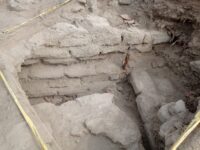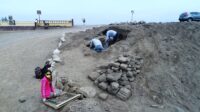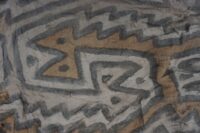 An excavation of ancient mounds on the Cerro Colorado hill on the outskirts of Barranca, a port city on the central coast of Peru, has unearthed a monumental temple complex more than 4,000 years old.
An excavation of ancient mounds on the Cerro Colorado hill on the outskirts of Barranca, a port city on the central coast of Peru, has unearthed a monumental temple complex more than 4,000 years old.
A joint team of archaeologists from Peru and Poland excavated two of the four known mounds on Cerro Colorado. The initial small-scale surveys quickly encountered dried bricks and stone blocks. More extensive excavation unearthed a brick and stone pyramidal building. The blocks were bound by a mixture of grass and mortar. It was the grass of the mortar that was radiocarbon dated to between 2500 and 2200 B.C.
 This was a period when agriculture became widespread among Andean cultures via contact with Amazonian peoples who had established agriculture-based communities thousands of years earlier. With farming came urban settlements and monumental structures, including temple pyramids. The largest Andean pyramidal temple constructions from the 3rd and 2nd millennium B.C. are at the ancient site of Caral 20 miles southeast of Barranca. The discovery of the Cerro Colorado temples expands the known geographic range of these complexes to the Pacific ocean.
This was a period when agriculture became widespread among Andean cultures via contact with Amazonian peoples who had established agriculture-based communities thousands of years earlier. With farming came urban settlements and monumental structures, including temple pyramids. The largest Andean pyramidal temple constructions from the 3rd and 2nd millennium B.C. are at the ancient site of Caral 20 miles southeast of Barranca. The discovery of the Cerro Colorado temples expands the known geographic range of these complexes to the Pacific ocean.
Even after the cultures that built them fell and the pyramids’ original religious functions were abandoned, the sites were still recognized as sacred for millennia. In the recent excavation, archaeologists discovered burial bundles at the top of the highest mound. Radiocarbon dating of organic remains from the burials date them to between 772 and 989 A.D., at least 3,000 years after the pyramids were built, when the area was part of the Wari Empire.
 One of the graves contained the remains of a young boy around six years of age when he died. His intentionally deformed skull marks him as a member of the elite, as does the extraordinary textile his body was wrapped in: a ten-foot-long rectangle decorated with zoomorphic motifs that is unique in the archaeological record of the Andes. His burial at the peak of the ancient mound also attests to his high social rank.
One of the graves contained the remains of a young boy around six years of age when he died. His intentionally deformed skull marks him as a member of the elite, as does the extraordinary textile his body was wrapped in: a ten-foot-long rectangle decorated with zoomorphic motifs that is unique in the archaeological record of the Andes. His burial at the peak of the ancient mound also attests to his high social rank.
The colonial clergyman and researcher of South American cultures, Antonio de la Calancha (1584–1654), vividly described the surroundings of the city of Barranca. De la Calancha said it was full of sorcerers and witches.
“He even went so far as to say that there was a ‘witchcraft university’ in Barranca. He also mentioned a temple where these sorcerers would gather to meet a ‘demon’ who would then scold them for praying in Spanish and dealing with Spaniards in general” – [excavation co-leader bioarchaeologist Łukasz] Majchrzak said. The Europeans of the time referred to the pre-Columbian gods as demons.
“The unique location of our site, the lack of analogous places in Barranca, and finally our finds indicate that the temple mentioned by the chronicler was located on Cerro Colorado” – emphasized the archaeologist.
According to him, this means that pre-Columbian religious traditions were continued there more than a hundred years after the start of the conquista. This means that Cerro Colorado has been a place of worship for almost four thousand years.
